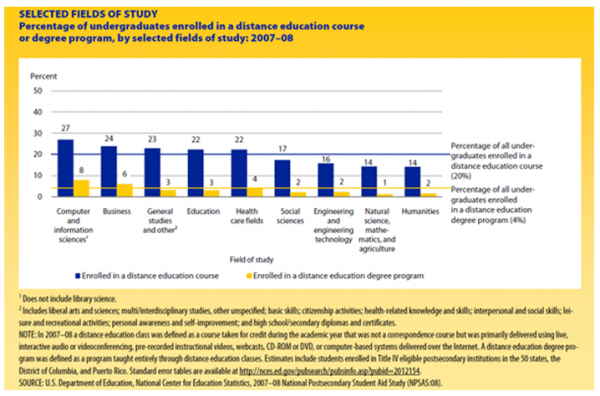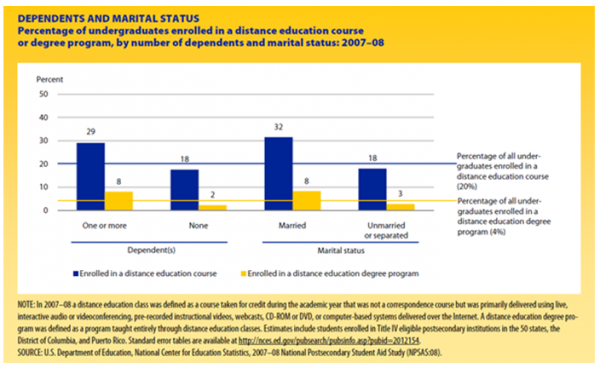
Campus Colleges vs Online Universities – Which Is Right for You?
Widespread access to the Web and online instructional courses has changed what students can expect from college today. Compared to a decade ago, online courses at the college level have gained acceptance as part of an advanced education. Governmental education subsidies and a national push to increase the number of people with advanced degrees have also played a role in the explosion of online learning options.
Program Availability & Enrollment
An increase in online course availability has helped students choose whether to take classes on a traditional campus or online. According to the U.S. Department of Education’s (DOE) National Center for Education Statistics, the five post-secondary institutions with the highest enrollment included:
- University of Phoenix’s Online Campus: 380,232 students
- Kaplan University: 71,011 students
- Arizona State University: 68,064 students
- Miami-Dade College: 59,120 students
- Ohio State University: 55,014
Student enrollment has also increased within the past decade. From 2000 to 2008, the percentage of undergraduates enrolled in at least one distance education class expanded from eight percent to 20 percent, and the percentage enrolled in a distance education degree program doubled. Participation in a distance education course was most common among undergraduates attending public two-year colleges and for-profit institutions.
A recent Sloan Consortium report (2011) illustrates that fall 2010 online enrollment in college courses accounted for 31.3 percent of total college enrollment. This represents a 10 percent growth rate for online enrollments, which far exceeds the two percent growth in the overall higher education student population.
Online programs are taking a growing share of the student population, and to keep growing, those programs will have to keep finding innovative ways to compete with traditional campus colleges.
Popular Online Courses
Though distance learning is growing in popularity, the growth is not evenly distributed across fields of study. The most popular online courses and degree programs are in computer and information sciences and business. Other popular subjects for online degree-seekers are:
- General Studies (23% of online course-takers)
- Education (22%)
- Health Care Fields (22%)
- Social Sciences (17%)
- Engineering and Engineering Technology (16%)
- Natural Science, Math and Agriculture (14%)
- Humanities (14%)
Schedule Flexibility
The ability to take an online course whenever you have free time proves especially handy for older students with a spouse, a dependent or with full-time employment. Older undergraduates also participated in both distance education classes and degree programs relatively more often than their campus counterparts. The chart below compares online course enrollment between students with and without dependents, and married and unmarried students. Additionally, students with mobility impairments enrolled in distance education courses more often than students with no disabilities.
Online Courses vs. Online Degrees
Education is not a “one-size-fits-all” endeavor. Advances in technology provide an opportunity to personalize education, use time more efficiently, and tailor instruction in innovative ways. Online course work enables students to attend class inside or outside of school, learn concepts at an individual pace, and receive extra help or more challenging assignments. Online degrees have their own set of drawbacks, though. Some of the problems concerning online education include:
- Lack of personal interaction with fellow students and professors.
- Worry that employers may not view online degrees as equivalent to traditional degrees.
- Cheating may be easier, leading to doubts about the degree.
- Difficulty of sorting out good programs from less rigorous ones.
These concerns are valid, but it is up to each student to decide whether online or on-site education suits her or him best. If you choose online, research your chosen school and make sure they are accredited and that the credits you earn can be transferred if you decide later that you want to finish your degree at a traditional school. You can determine if an online degree is accredited by checking the DOE Database of Accredited Postsecondary Institutions and Programs.
Although the DOE does not endorse any program nor does it accredit educational institutions or programs, it does approve the accrediting agencies. The Secretary of Education publishes a list of nationally-recognized accrediting agencies and accredited schools.
Online Costs vs Traditional Costs
Though online courses are widely perceived to be cheaper than on-campus ones, students may discover that online courses and degrees are no less expensive than a traditional college education. The actual price of tuition, with financial aid factored in, is highly variable depending on the student’s need and the initiative they take in seeking scholarships.
Students taking online courses can save money on costs other than tuition, though. They can:

- Save on room and board by avoiding college dorms or expensive on-campus housing.
- Avoid transportation costs going to and from classes, especially if at a distance.
- Save on babysitters if parenting.
According to College Board’s Trends in Higher Education, traditional students faced an average of $6,480 in room and board, books and supplies, transportation, and other costs after grant aid in 2007-08.
About two-thirds of all full-time undergraduate students receive grant aid, as reported by CollegeBoard. In 2009-2010, students at public four-year colleges received about $5,400 each in financial aid grants and tax benefits. That figure rose to $14,400 for private four-year college students, a figure that includes online students.
Which Path is Right for You?
Online degree programs are typically attractive to students who are married, have dependents or have a full-time job. Additionally, you may feel more compelled to earn a college degree online if you want to major in computer science or business and if you are mobility disabled. If you’re on the fence, ask yourself the following questions to assess your aptitude for online learning:
- Am I a self-starter?
- Do I manage my time well?
- Can I work alone without supervision?
- Am I comfortable on the computer and using the Internet?
Traditional education still has benefits for those who want to leave home and live on their own or in college dorms. The college life, with its fraternities, parties and personal interactions is an experience that often creates deep and lasting relationships and provides networking opportunities for future careers.
The choice between campus colleges and online universities warrants careful consideration, but since the gap in earning potential between students with a high school diploma and a bachelor’s degree can exceed $800,000 over a lifetime, either online or campus based education is definitely preferable to none at all. It is important to do careful research while working out the details, and to remain confident that furthering your education will pay off over time.
/campus-colleges-vs-online-universities-which-is-right-for-you

